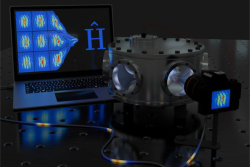
Quantum simulators are a completely new tool for research: quantum physics is studied by other kinds of quantum physics. Research teams from Innsbruck and Vienna are developing a new method that will allow this new technology to be reliably verified.
Quantum physics is a very diverse field: it describes particle collisions shortly after the Big Bang as well as electrons in solid materials or atoms far out in space. But not all quantum objects are equally easy to study. For some – such as the early universe – direct experiments are not possible at all. However, in many cases quantum simulators can be used instead: One quantum system (for example, a cloud of ultracold atoms) is studied in order to learn something about another system that looks physically very different, but still follows the same laws, i.e. adheres to the same mathematical equations.
It is often difficult to find out which equations determine a particular quantum system. Normally, one first has to make theoretical assumptions and then conduct experiments to check whether these assumptions prove correct. Strikingly, researchers at the University of Innsbruck, the Institute of Quantum Optics and Quantum Information (IQOQI) and TU Wien (Vienna) have now jointly achieved an important step in this field: they have developed a method that allows them to read directly from the experiment which physical theory effectively describes the behaviour of the quantum system. This now allows for a new kind of quality control: it is possible to directly check whether the quantum simulator actually does what it is supposed to simulate. This should enable quantitative statements to be made about quantum systems that cannot be investigated directly.
Measurements with analogue experiments
“In quantum physics, you often come across very complicated equations. When a large number of particles are involved, even the world's largest supercomputers are hopelessly overwhelmed,” says Robert Ott, postdoctoral researcher in Hannes Pichler's group at the University of Innsbruck. A different approach is therefore often more helpful: “If you have a system of quantum particles that you can control and measure very precisely, then in some cases other quantum systems can be modelled with it. This allows you to carry out a kind of ‘analogue experiment’. You can imagine this as being similar to experimenting with water waves, for example, in order to learn something about sound waves,” explains Maximilian Prüfer from TU Wien.
Clouds of ultracold atoms are a particularly interesting variant of such quantum simulators. At TU Wien, Prof Jörg Schmiedmayer's working group uses so-called atom chips to hold, manipulate and investigate these atom clouds in a highly controlled manner. “In these atom clouds, excitations occur on large scales that obey the same mathematical equations as other quantum physical phenomena that appear in completely different situations,” says Maximilian Prüfer, who is leading an experiment in the working group with funding from an Esprit Fellowship from the FWF. “So we want to know: What exactly do these equations that our system of ultracold atoms obey look like? Do they match the fundamental laws that a certain other quantum system obeys?”
Theory and experiment
Comparing theory and experiment is, in a sense, the core of natural science: “Normally you consider which theory might be the right one for a particular situation and then you compare the resulting findings with the experiment,” says Robert Ott. “If they match, that's an indication that the theoretical description is correct. If not, you have to come up with a new description.”
In the case of the quantum simulator, however, things are a little different: the team has developed a way of reading the mathematical laws that the system adheres to in a particular situation directly from the experiment. Deriving these laws theoretically from basic physical laws would be extremely difficult. The large number of atoms involved, which interact with each other in complex ways, makes it almost impossible to derive these equations.
A building block method for finding equations
“The so-called Hamilton operator is crucial in quantum theory,” says Robert Ott. “This is a mathematical object that describes how a quantum system will behave.” This Hamiltonian operator can take on different mathematical forms: Different types of interactions between the particles can occur in it, various parameters are contained in it that describe how big a role these interactions play in each case. To a certain extent, there is a known set of ‘building blocks’ from which this Hamiltonian operator can be assembled.
“We have now been able to show If you measure the atomic clouds in a suitable way, then you can read directly from certain correlations of these measurement results which relevant interaction terms make up the Hamilton operator, and which parameters occur in them,” says Maximilian Prüfer. “We don't have to carry out complex computer simulations first and then compare them with the measurement results; instead, with our new method, we can read directly from the experimental data what the crucial formula looks like.”
This is an important step for the verification of such quantum simulators. “Using our method, we can show that the quantum simulator actually does what it is supposed to - and can therefore be translated to another quantum system that cannot be investigated directly in an experiment,” says Robert Ott.
These questions are also an important part of research in the QuantA Cluster of Excellence, which is working on quantum simulators both experimentally and theoretically. The research team is confident that quantum simulators will make it possible to derive statements about complicated quantum systems in the future that would never have been possible using other methods, such as computer simulations.